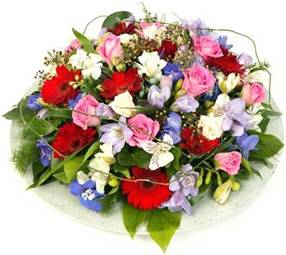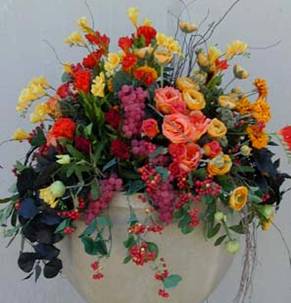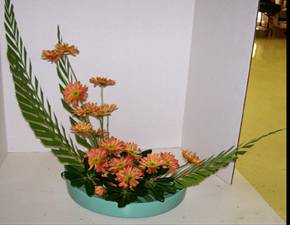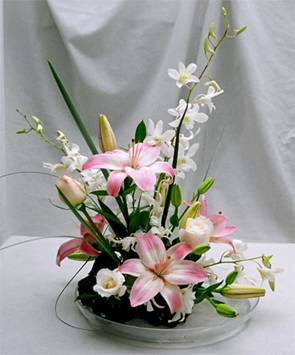FRESH FLOWER ARRANGEMENT
Flower arrangement is a tribute to nature and her profound creation – an attempt to establish a communion with nature, by capturing some of splendor and framing it in an individually conceived design. As such, it may also be considered an art, as it invokes the aesthetic faculties of the mind. But most of all, it is pastime that is rewarding and involving.
One of the greatest advantages of flower arranging is that you can produce as attractive effects with the humblest of materials, like a twisted branch picked up during your morning walk, and just a few blooms gathered from your garden as you can with a luxurious variety of flowers. Conventionally, there have been two different approaches to floral designs: western styles, employing a ‘mass’ concept of arranging flowers in an even symmetry, and the eastern or Japanese or Ikebana styles, which are based on specific rules and angles, using less material.
Some of the basic differences between eastern and western arrangements are
- Primarily western style is symmetrical arrangement, but eastern style is asymmetrical one.
- Western arrangements employ more flowers to create mass effect, but eastern styles impress more by the beauty of individual material.
- Contrary to western arrangements the materials in Japanese never touch the rim of the vase.
- Accessories are never used in western arrangements. But in Ikebana interesting branches, drift wood, pieces of bark, shells etc., are used to imitate the nature. Here the more emphasis is given on western arrangements.
Western styles of flower arrangement
Western style flower arrangements are associated with ‘mass’ or a number of flowers and foliage arranged together in a graceful manner.
In England and Europe, this style was first used to decorate palaces, mansions and churches. Traditionally, triangular, round or oval shapes were created, but after the Second World War, more designs like the L-Shape, Crescent and S-Shape were introduced. These are said to be more American in their influence.
Western designs may be scaled to large proportions and with their symmetrical patterns; they can give a touch of grandeur to a formal occasion. Small compositions look equally pretty, but whatever the size may be, it is better to go in for these styles when there is a generous availability of material. A few typical nuances of such styles can be mentioned as guidelines. These are:
- The outline of the design is normally created first with finer, lighter ‘lines’ so that the shape of the style is defined.
- There is not much emphasis on individual plant material due to the mass effect, but in the more recent western styles, ‘points’ are woven through the ‘fillers’ so that a certain planning is evident within the mass effect and the design looks more attractive. Colours are also used in the same manner.
The arrangement gives a flowing, radiating effect originating as it were, from the rim of the vase, where the focus has been created with heavier points.
Getting a good start
A vase for a western arrangement requires to be fitted with a pin holder as well as a wire-netting. It also make use of an ‘ oasis’ or a block of plastic foam which is very light but becomes solid and heavy when it is immersed in water for approximately twenty minutes. The block can be conveniently cut with a knife and is fitted to fill the entire diameter of the vase. It is easy to simply push in the flowers in this sponge-like substance, but being damp, once the stems are fixed, it is advisable not to remove them as the oasis starts to crumble. As it retains water, flowers last in an oasis just as they would in a vase, but a fresh oasis has to be used each time for an arrangement.
Different models
- The triangular model
- The Round bowl model
- The Oval bowl model
- The L-Shape model
- The S-Shape model
- The Crescent shape model
1. The triangular shape
Begin by first fixing the central line (A), keeping it in proportion to the vase and fixing it upright at ninety degrees. Next, insert lines (B), each about three-fourths the length of the main line, so that they lie horizontally over the rim of the vase on either side of an imaginary triangle. Insert two more lines, (C) and (D), this time short, and of unequal lengths. Place these horizontally and forward over the rim of the vase, in line with (A). These establish the width of the arrangement.
Now you can proceed with filling up the distance between (A) and (B) on either side in a symmetrically graded manner. As you make your material descend, fix it outward, the slant being more distinct with each line. Also ensure that the material is kept short, about half-way down the vase and again increases in length as you approach the rim, so that it finally merges with the outer arms (B). Compose the rest of the arrangement with graded tiers of fillers, at the same time adding points in the manner desired, working towards the focus.
Choice of the pots: A brass vase
Choice of the plants:
Nine double tuberoses – A – central line
Six yellow gladioli – B
Eighteen pink roses – C & D
Nine money plant leaves – to fill the gap
Four variegated spider lily leaves – to balance the rose
One bunch of Thuja leaves – to cover the wire netting |

|
| Triangular shape arrangement |
|
2. The round bowl model
For setting the main lines of an all-round arrangement, you will need at least eight flowers for the periphery. Wedge four flowers of equal length (A) through the grill diagonally across each other. Along the same lines, insert four slightly shorter flowers (B). These long and short pairs serve to give you guidance for creating ‘movement’ in the arrangement. Now, take an erect flower (C) and fix it in the centre of the pin holder. This defines the height of the arrangement. If it is for a sit-down dining table, the central line should not be more than nine inches high so that is does not obstruct the vision of those sitting across the table. Fix four slightly shorter flowers (D), around (G).
From this central group, you will find it easy to proceed with the rest of the arrangement. Keep turning the vase, working on all four sides simultaneously. Begin by fixing the first pair of flowers between the gaps in the central group and grade the flowers outwards, filling in the alternate spaces to merge with the outer points of the circumference. Use heavier flowers or full blown blooms for the depth or short lengths, and buds or feathery material for the longer lengths, working within the framework of the symmetrical round. Fillers can be worked in similarly.
The longer the lengths of your peripheral lines and central line, the more flowers you will require for the arrangement. No foliage is used as the buds at the tip of the antirrhinums are contrast enough to intersperse the round forms of the roses.
Choice of the pots: A round bowl
Choice of the plants:
Two dozen double coloured orange and yellow roses – A,B &C
One-and-half dozen antirrhinums – D & fillers |

|
| Round bowl model arrangement |
|
3. The oval bowl
For this, an image of a rectangle must be kept in mind. The lines at the sides (A) are therefore kept long. Grouped along these main lines are (B) and (C), of different lengths, corresponding with each other in perfect symmetry on both sides. The width is determined by two short lines, (D) which are on both sides and in front of the vase, being roughly one-fourth the length of (A). Like in the round bowl, take an erect flower for the central line (E). This must necessarily be kept low as oval bowls are usually placed on conference tables/dining tables or mantelpieces.
From the central line, on either side, grade the flowers down in the manner of fan so that the lengths of the material will slant and increase as it is arranged to merge with the outer points at the sides. Now you can proceed with filling in the vase. Remember to maintain the ‘movement’ with short and long stems, within the oval framework. Turn the vase around and work similarly on the other side.
Choice of the pots: Rectangular and boat shaped containers vase
Choice of the plants:
Twenty-one yellow roses – A,B,C,D,E
Two dozen sweet Williams as fillers
Two bunches of gypsophila as fillers |

|
| Oval bowl model arrangement |
|
4. The L – shape
This design is easy to make if you conform strictly to the L-Shape. If you are using a rectangular container, place the pin holder in one corner of the vase, depending on which may you would like to face your L.
Fix two main lines (A) of equal length at a right angle. While the perpendicular line will be fixed in the pin holder, the horizontal line will have to be wedged through the wire mesh so that it lies parallel to the bowl. On either side of the vertical arm, fix two shorter lengths, (B) and (C) and repeat the same for the horizontal line will have to be wedged through the wire mesh so that it lies parallel to the bowl. On either side of the vertical arm, fix two shorter lengths, (B) and (C) and repeat the same for the horizontal arm. As in the triangular style, a width is established with two short lines (D) and (E) inclining over the vase at the rim, in front of the main line.
Fill in the next tier of material between the spaces of the vertical arm, grading it down narrowly and increasing it from the vortex of the L to follow the horizontal line sideways. You can arrange the points according to your own discretion, but make sure to concentrate the focus at the vortex of the right angle.
Choice of the pots: Rectangular container
Choice of the plants:
Six white gladioli – A, D
One-and-a-half dozen larkspurs – B
Two dozen sweet sultans – C
One dozen pink roses – E
Small bunch of Gypsophila – fillers
Three aspidistra leaves – curving outwards |
 |
| L-shape arrangement |
|
5. The S-shape
The outline of this style must be made with curved material or with pliable branches that can be manipulated to take the form of the S. The placement of lines is in groups of three, just like in the L. Take two main curved lines (A), one facing up and the other down to form the S. Fix lines (B) and (C) on either side of (A) corresponding to each other on opposite sides. Concentrate the density of the flowers and foliage towards the rime of the vase, where the inward facing curves meet the outward curves facing down. In this way, the outline of the S will show up better.
Choice of the pots: Vase with a stem (or) a tall vase
Choice of the plants:
One dozen larkspurs – C
Five marigolds
Seven tuberoses – B
Five white sweet sultans
Three asparagus ferns
Four areca palm leaves – A |
 |
| S-shape arrangement |
|
6. The crescent shape
This half-moon shaped arrangement also needs curved material to form the image of the crescent in which the two arms of the arrangement look inwards at each other. Take an inward curving line (A) and fix at one side of the pin holder. Take another curving line (B), two-thirds the length of (A). As in the previous styles, fix two different curving lengths on either side of (A), corresponding them to the lines on either side of (B). Fill in the space between the crescent by arranging the material in a manner in which the flowers are shorter and heavier towards the base of the vase and lengths increase again to face inwards as they rise to go along the curve (B).
Choice of the pots: A vase with stem
Choice of the plants:
Three Royal lilies - B
Six fishbone ferns
Three Cycas (Sago) palm leaves - A
Twelve red carnations - C
Three red carnations - C
The above mentioned styles, pots and plants are just to create basic idea of western flower arrangements. By using these basic principles one can create his own styles with available pots and plants. |
 |
| Crescent shape arrangement |
|
Eastern or Japanese or Ikebana styles
Ikebana is the Japanese art of flower arrangement, also known as kado, the "way of flowers". More than simply putting flowers in a container, ikebana is a disciplined art form in which nature and humanity are brought together. Contrary to the idea of floral arrangement as a collection of particolored or multicolored arrangement of blooms, ikebana often emphasizes other areas of the plant, such as its stems and leaves, and draws emphasis towards shape, line, form. Though ikebana is a creative expression, it has certain rules governing its form. The main rule is that all the elements used in construction must be organic, be they branches, leaves, grasses, or flowers. The artist's intention behind each arrangement is shown through a piece's color combinations, natural shapes, graceful lines, and the usually implied meaning of the arrangement.
Another aspect present in ikebana is its employment of minimalism. That is, an arrangement may consist of only a minimal number of blooms interspersed among stalks and leaves. The structure of a Japanese flower arrangement is based on a scalene triangle delineated by three main points, usually twigs, considered in some schools to symbolize heaven, earth, and man and in others sun, moon, love and earth. The container is also a key element of the composition, and various styles of pottery may be used in their construction.
Irrespective of the styles each flower arrangement contains the following three components. |
 |
| Ikebana style arrangement |
|
- Containers: The containers or vases for flower arrangement differ in size, shape and material. it may be of porcelain, ceramic, brass, bell metals, bamboo, drift wood etc. Glass containers are not generally preferred as vases. The size of the containers varies from tall vases to flat saucers. Symmetrically or asymmetrically shaped containers are preferred depending upon the type of flower arrangement. The colour of the containers should not be bright; as such containers will detract the beauty of the blossoms. Besides the above containers, split bamboos or pieces of bamboo with two or three in internodes having holes can be also employed as natural containers especially for line arrangement. Sometimes drift wood (pieces of any lignified woody stem) with a depression on its top portion may be also used as containers for line arrangement.
- Mechanism: It refers to the physical mechanism by which flowers are held in oisition in containers. Pin-holders, clay balls or a crushed wire mesh are all commonly used in containers to hold the flowers in position. Deep containers generally do not require a mechanism. However, it is a must for flat and shalloe containers. In some cases, the flowers have long and weak stalks. In such cases, the mechanism alone will not suffice to keep the flowers din position where a thin GI wire can be pushed inside the stalks to retain in position. Mechanism of flower arrangement should be such that all the stalks of the cut flowers must originate from a point. The exposed stalk of the cut flowers as far as possible must be 11/2 times the height of the containers.
- Flowers: The term ‘flowers’ in flower arrangement include real flowers, foliage, dried twigs. fruits (fresh or dry). Dry and fresh flowers may be combined or arranged separately. Colour combination adopted in a flower arrangement is highly based on individual taste and preferences.
In massing or grouping of flowers, care must be taken to have proper balance and proportion between the container and the flowers. When different flowers are combined orange coloured flowers may be combined with red flowers or blue flowers with violet coloured flowers. It is always attractive to combine all light colours or all bright colours in a vase.
Prolonging the vase life of flowers
How long the flowers kept in the containers remain fresh is referred to as vase life of flowers. This is dependent upon many factors like temperature, relative humidity, light, air velocity, composition of the holding water etc. The vase life can be extended by the following methods.
- Prevention of pollination: Flowers begin to fade after fertilization. Therfore main purpose is to delay this natural process. This explains why double flowers keep longer than single flowers. To prevent pollination, the easiest way is to remove the stamens from the flowers when they open. By this method, the vase life of Lily flowers could be extended by 10 days.
- Prevention of blocking of the conducting vessels of the flower stalks: Air pockets sometime block the conducting vessels, thereby causing the flowers to fade quickly. Blocking can be prevented by the following methods.
- By dipping the stems of cut flowers in boiling water for 20 -30 seconds. (e.g. Rose, Iceland poppy, Dahlia, Zinnia, Chrysanthemum, etc.)
- By burning the stems of the cut flowers for 15 seconds (e.g. poppy)
- By dipping in dilute acids like N/500 nitric acid.
- Splitting the stems in woody flowers like hydrangea, Rhododendron before placing them in cold water.
- Sometimes blocking is also due to bacterial growth at the cut end.
This can be prevented by any copper fungicide treatment or by dropping a coppercoin into the vessel.
Use of preservative solutions has been known for many years in lengthening the vase life of cut flowers. Preservatives normally include sugars, biocide, anti-ethylene compound and hydrated compound. Silver thio sulphate is an anti-ethylene compound in the preservative solution while quinoline compound is a biocide.
Source
1. http://en.wikipedia.org/wiki/Ikebana
2.http://lh3.ggpht.com/_OVtOM-JqUfA/STzS4ydbP7I/AAAAAAAAGiY /dmI9YrIzr_E/s800/Angel4.jpg
3. http://www.flower-arrangement-advisor.com/images/L_shape_fillers.jpg
4.http://www.made-in-china.com/image/2f0j00CMFtPOwISQkdM/Porcelain-Flower-Basket.jpg
5. http://www.makebe-leaves.com/top_image/Tuscany_med_top.jpg
6. http://www.fs-evergreen.com/pic/intro-p/sshape.jpg
7. http://i137.photobucket.com/albums/q228/bocasgarden/Floral%20Design/Floral-Design-123.jpg
8. http://www.gloriousfloraldesigns.com/images/IkebanaJPGO/IkebanaPinkLily.jpg
9. http://www.wise4living.com/hdarti/images/dried-arrangement.jpg
10. http://www.mauidriedflowers.com/images/dried_bamboo_lg.jpg
11. http://www.driedflowersdirect.com/art-and-craft/st5full.jpg
12. www.floristsregister.com/how_to_dry_flowers.php
13. http://www.freshflowersandgifts.com.au/shop/images/big/D23.jpg
|
|